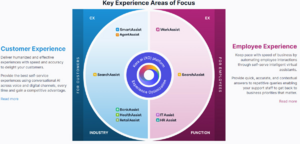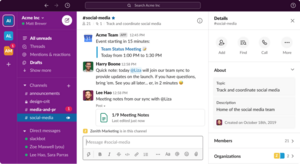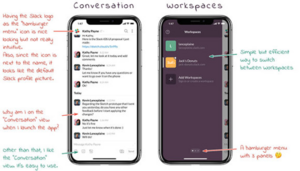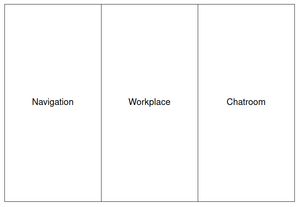Public:SC Office: Difference between revisions
Richika Rana (talk | contribs) |
|||
| (25 intermediate revisions by 4 users not shown) | |||
| Line 1: | Line 1: | ||
= Vision = | |||
[[File:Public:Customer and Employee Experience together.png|thumb|Customer and Employee Experience - both target markets targeted by Kore.ai]] | |||
Trying to build a Holistic Solution<ref>[https://greylock.com/greymatter/seth-rosenberg-product-led-ai/ Product Led AI]</ref> which is a mix of : | |||
<nowiki>*</nowiki> Knowledge Management & Enterprise Search like getguru.com, rewind.ai | |||
<nowiki>*</nowiki> Team Messaging like Microsoft Teams / Slack | |||
<nowiki>*</nowiki> Collaboration Wiki like Notion.so | |||
<nowiki>*</nowiki> Time Tracking like HubStaff.com | |||
= User Experience = | = User Experience = | ||
Conventional Team Messengers have Navigation on the left, and Chatroom on the right like this | Conventional Team Messengers have Navigation on the left, and Chatroom on the right like this | ||
| Line 8: | Line 20: | ||
|- | |- | ||
|Slack | |Slack | ||
|[[File:Slack Desktop.png|left|thumb|Slack Desktop. Left Navigation. Right chatroom]] | |[[File:Public:Slack Desktop.png|left|thumb|Slack Desktop. Left Navigation. Right chatroom]] | ||
|[[File:Slack Mobile.png|left|thumb|Slack Mobile. Left Navigation. Right Chatroom]] | |[[File:Public:Slack Mobile.png|left|thumb|Slack Mobile. Left Navigation. Right Chatroom]] | ||
|- | |- | ||
|MS Teams | |MS Teams | ||
| Line 36: | Line 48: | ||
!Mobile | !Mobile | ||
|- | |- | ||
|[[File:SC Office User Experience Anatomy.png|thumb|SC Office Web User Experience: Left Navigation. Center Workplace. Right Chatroom]] | |[[File:Public:SC Office User Experience Anatomy.png|thumb|SC Office Web User Experience: Left Navigation. Center Workplace. Right Chatroom]] | ||
|Navigation could be docked & pinned on the left of desktop | |Navigation could be docked & pinned on the left of desktop | ||
User can continue to open whatever apps they want on their desktop. That becomes their workspace | User can continue to open whatever apps they want on their desktop. That becomes their workspace | ||
| Line 88: | Line 100: | ||
A chatroom will be created for every node selected inside navigation | A chatroom will be created for every node selected inside navigation | ||
=== | === Configure Channel & Filter against nodes === | ||
connected will create child nodes against certain category inside navigation | connected will create child nodes against certain category inside navigation | ||
=== Labeling Chat messages === | |||
<nowiki>#</nowiki>upskilling should help HR team to know what needs their attention | |||
=== While customers respond, enterprise search would be used to source answer from documents === | === While customers respond, enterprise search would be used to source answer from documents === | ||
| Line 112: | Line 127: | ||
== Notifications == | == Notifications == | ||
Using "near natural language" the notification would be split in following types | Using "near natural language" the notification would be split in following types | ||
=== For each Node in Treeview === | |||
=== Where I am === | === Where I am === | ||
| Line 125: | Line 142: | ||
===== ..to be Informed (Acknowledge something) ===== | ===== ..to be Informed (Acknowledge something) ===== | ||
=== Notifications in Wiki (less noisy) than Notifications in Chat (more noisy) === | |||
=== Timeboxing === | |||
See [https://teams.microsoft.com/l/message/19:b52f27e54ecb4396a42b89ba11c3e68d@thread.tacv2/1604900372551?tenantId=7bfc4b7d-f115-4dfc-ba94-8b9f75394558&groupId=1720569b-102b-467a-b3c2-1abf53a240f9&parentMessageId=1604900372551&teamName=A%20Better%20MS%20Teams&channelName=WHY&createdTime=1604900372551&allowXTenantAccess=false here] | |||
== Organizing Knowledge == | == Organizing Knowledge == | ||
| Line 135: | Line 157: | ||
==== Query String URL based on a customer parameter ==== | ==== Query String URL based on a customer parameter ==== | ||
experimental. don't code it yet until the idea matures | experimental. don't code it yet until the idea matures | ||
== Prompt Guideline when Colleague is Working == | |||
Managers (CXO, PMs Or Leads) will be able to train CV to identify when Colleague is about to do a key action on their screen, like: | |||
* commiting some code | |||
* Posting a job on upwork | |||
* Contacting a candidate over linkedin / email | |||
A guideline article from wiki would be pulled up on the screen. Colleague would be able to either just read the guideline or mark the checklist in guideline wiki as complete. | |||
The guideline would prompted on colleague's screen using an on-screen notification appearing just next to their caret/mouse/button where they were performaning this action | |||
== Talk to your Screenshots == | |||
# Developers can ask the time taken by them on technologies, modules, and projects | |||
## It can be used by developers to improve themselves | |||
## it can be used to revisit some past work | |||
## it can be used by sales teams for better time estimates | |||
# Such as we can ask "how much time was taken to implement SSO", "how much time was taken add dgraph" | |||
# It can also be used to audit timesheets for a filed claim | |||
## Recently I (mayank) have to manually audit screenshots when a client claimed that we used time to learn basis such as git and redis. But the manual search to prove that the calim was invalid too large effort and could be saved by talking to screenshots | |||
== Enterprise Search == | == Enterprise Search == | ||
Inside the constantly increasing organized knowledge, an enterprise search would be performed. Any questions asked to the Document chatbot would be answered by crawling all the documents crawled inside the selected navigation node and answered | Inside the constantly increasing organized knowledge, an enterprise search would be performed. Any questions asked to the Document chatbot would be answered by | ||
* crawling all the documents crawled inside the selected navigation node and answered | |||
* learning from all the past conversations that happened inside selected navigation node and answered | |||
= Capabilities = | = Capabilities = | ||
| Line 157: | Line 203: | ||
== Time Tracking == | == Time Tracking == | ||
Screen to | |||
=== Track time based on what node is open === | |||
Notice what node is currently selected by user in the navigation. Track user's time inside that node. | |||
=== Idle Time detection === | |||
Like they have in Hubstaff<ref>[https://support.hubstaff.com/how-does-the-inactivity-warning-work/ Idle time feature in Hubstaff]</ref> | |||
=== Screen to Navigation-node === | |||
Uses CV (with NL and Document AI) to understand whats open on user's screen. And based on that automatically navigate the user to another node in navigation. See [https://smartercodes.sharepoint.com/:v:/s/Knowing.dev/EQaVFZechdNFrR5TbMSzf6YBFHkJjf_xAJsBNGv-q-ZWAA?e=ZKidpj this video between Tushar and David] | |||
== Time Budgeting == | |||
=== Set budgets per node === | |||
=== Resource allocation of person === | |||
=== Track (future) overage of budget === | |||
=== Alerts raised by bots and humans === | |||
== Chat to Task/OKR/Objectives CRUD == | == Chat to Task/OKR/Objectives CRUD == | ||
| Line 166: | Line 230: | ||
= Success Metrics = | = Success Metrics = | ||
The | The metrics with which we measure that SC Office is more helpful than MS Office | ||
== Users are reminded when KPIs aren't met == | |||
=== ICs === | |||
==== Engineers ==== | |||
Weekly: Release URL | |||
Weekly: QA Report | |||
==== Designers ==== | |||
==== Marketers ==== | |||
==== Sales ==== | |||
=== Managers === | |||
==== All Managers ==== | |||
Weekly (start): Issue Board | |||
Bi-weekly: QA Report | |||
Bi-weekly: client updates | |||
==== Project Managers ==== | |||
Weekly (end) : Money released | |||
=== CXOs === | |||
Team has enough work | |||
Team has received feedback | |||
== Number of irrelevant notifications drop, & relevant notifications increase == | == Number of irrelevant notifications drop, & relevant notifications increase == | ||
== Time | === Time of resolution of colleagues improve === | ||
== % of | === Time saved in deciding where to post a message === | ||
=== % of information organized under hierarchy is increased === | |||
== Writing styles of updates should met with update guidelines == | |||
== Amount of time saved finding important documents / links == | == Amount of time saved finding important documents / links == | ||
== Engineering == | |||
=== Jira Board: === | |||
[https://smartercodes.atlassian.net/jira/software/c/projects/S87FF21EEB/boards/64 Click here] for Jira board | |||
=== Bitbucket Repository: === | |||
[https://bitbucket.org/smartercodes-repo/workspace/projects/SD326A5726 Click here] for SC HC Inbox Sandbox repo | |||
[https://bitbucket.org/smartercodes-repo/sc-hc-inbox-chat/src/develop/ Click here] for SC Office Frontend repo | |||
[https://bitbucket.org/smartercodes-repo/sc-talking-db-backend/src/develop/ Click here] for SC Office Backend repo | |||
[https://bitbucket.org/smartercodes-repo/sc-desktop-osclient/src/main/ Click here] for OS Client repo | |||
=== Test Data: === | |||
For tracking this test data we have a Drive folder for [https://drive.google.com/drive/u/0/folders/1CJUkn_0Slbtdaye-Sha892cU9VZVZ-5b HC Framework] with sub folder called "SC Office" . You can upload newly requested data into this 'SC Office' folder and name it with a revision ID. | |||
for example, 'Tree_View_Navigation_View-01' | |||
# SC Office: Tree View Navigation (Provided) ( Schema, Source, sample): | |||
## For Schema refer [https://smartercodes.atlassian.net/browse/S87FF21EEB-67?focusedCommentId=50970 here], | |||
## Source is [[Special:MostLinkedCategories|docs.smarter.codes]] | |||
## Sample is [https://smartercodes.atlassian.net/browse/S87FF21EEB-67?focusedCommentId=50970 here]. | |||
#Default Image for wiki-pages ( requested ): | |||
##For Sample refere [https://smartercodes.atlassian.net/browse/S87FF21EEB-78?focusedCommentId=51122 here] | |||
#Docs.smarter.codes dump file for Category, Sub-category and Article ( Requested ): | |||
##For sample schema refer [https://smartercodes.atlassian.net/browse/S87FF21EEB-67?focusedCommentId=50970 here] | |||
##RDF dump file extracted from docs.smarter.codes [https://drive.google.com/file/d/1pJ9UjH1g4YIlK2TdTS0hSvKpaLJzq_0b/view?usp=sharing here] | |||
#HubStaff projects list to add in docs.smarter.codes and import in node view -> SC Office: | |||
##For spreadsheet refer [https://smartercodes-my.sharepoint.com/:x:/g/personal/richika_r_smarter_codes/EbUsLGQiQwdPk7O5m8mj3LoBulWTrh_GKVTve2Sz_3--rQ?e=cGNcM9 here] | |||
Refer this [https://drive.google.com/file/d/1Xy8eDSIOD3ciHZiXGFCo2iRkfqslmYda/view video] for Adding, requesting and tracking test data. | |||
= References = | |||
<references /> | |||
[[Category:SC Office]] | |||
Latest revision as of 10:49, 14 March 2024
Vision

Trying to build a Holistic Solution[1] which is a mix of :
* Knowledge Management & Enterprise Search like getguru.com, rewind.ai
* Team Messaging like Microsoft Teams / Slack
* Collaboration Wiki like Notion.so
* Time Tracking like HubStaff.com
User Experience
Conventional Team Messengers have Navigation on the left, and Chatroom on the right like this
A problem with Team Messengers is that everytime you have a chat, you later have to do extra work in filing your tasks, decisions, files from the chat into a Knowledge Base (like Confluence).
GetGuru.com tries to solve this. It integrates into the messengers (like Slack, Teams) and creates a Knowledge base for you (it offers a Wiki, or Knowledge base).
Our user experience offers
- A Messenger + (Self Organizing) Knowledge Base inside a single place.
- Not just a Knowledge Base, but also your "Workplace".
Down the line we will delve more into "Self Organizing" and "Workplace". But first let's see what the anatomy of our User experience will look like
N level Nested
Slack and Teams have a limit of 2 or max 3 level in Navigation. We would let N level. We would use Mediawiki category structure to let users create categories
Yet (nearly) Flat
You can see chat conversation and activity (in workplace) when you click on any node. You can see
- Only the activity / chat in selected node
- All the activity / chat nested inside the selected node
see Navigation Panel in TalkingDB
for every "View" created inside article page, we would create an item in navigation panel too
Workplace
Wiki pages
Mediawiki Article pages will open as user clicks on a node in Navigation
Spreadsheet / Kanban / Tasks
While Mediawiki powered articles pages would be the default option in Workplace, but like in Clickup you would have option to see
Mindmap
See Mindmap and Graph Software
⚠️ Your favorite Desktop or Web App
See
- Desktop.com
- https://www.producthunt.com/products/rambox
Chatroom
Chatroom for every node
A chatroom will be created for every node selected inside navigation
Configure Channel & Filter against nodes
connected will create child nodes against certain category inside navigation
Labeling Chat messages
#upskilling should help HR team to know what needs their attention
While customers respond, enterprise search would be used to source answer from documents
Enterprise search will use Document Chatbot. For every incoming customer message, a question or query would be formed and passed to the Enterprise search engine. Where a response will be suggested
Queries would be be context sensitive
Enterprise search should decide the filters that must be applied on queries such as, only the documents that belong to
- Certain category be be responded from (lets say we had a category / article named "North India" then queries must be returned only from inside that space
- Only data from inside customer's search history would be responded to
These contexts would be applied by NL on certain intents such as
- Last order
- other intents that are easy to train
User doesn't has to waste time deciding the location where message goes
People start typing a message, and a list of channels are searched, and suggested where the message must go
People start typing the message based on a window they had open
Notifications
Using "near natural language" the notification would be split in following types
For each Node in Treeview
Where I am
a Driver / responsible
as of RACI
mentioned..
..to Approve something (Take a decision)
..to Contribute something (Do a task)
..to be Informed (Acknowledge something)
Notifications in Wiki (less noisy) than Notifications in Chat (more noisy)
Timeboxing
See here
Organizing Knowledge
Chrome plugin to organize knowledge
Static URL
Time would be tracked when a navigation node is selected, and some internet history is used. I a URL is opened more than once while working while keeping the navigation open, then it's link would be added with "open count" posted against the URL. And stored inside Knowledge
Query String URL based on a customer parameter
experimental. don't code it yet until the idea matures
Prompt Guideline when Colleague is Working
Managers (CXO, PMs Or Leads) will be able to train CV to identify when Colleague is about to do a key action on their screen, like:
- commiting some code
- Posting a job on upwork
- Contacting a candidate over linkedin / email
A guideline article from wiki would be pulled up on the screen. Colleague would be able to either just read the guideline or mark the checklist in guideline wiki as complete.
The guideline would prompted on colleague's screen using an on-screen notification appearing just next to their caret/mouse/button where they were performaning this action
Talk to your Screenshots
- Developers can ask the time taken by them on technologies, modules, and projects
- It can be used by developers to improve themselves
- it can be used to revisit some past work
- it can be used by sales teams for better time estimates
- Such as we can ask "how much time was taken to implement SSO", "how much time was taken add dgraph"
- It can also be used to audit timesheets for a filed claim
- Recently I (mayank) have to manually audit screenshots when a client claimed that we used time to learn basis such as git and redis. But the manual search to prove that the calim was invalid too large effort and could be saved by talking to screenshots
Enterprise Search
Inside the constantly increasing organized knowledge, an enterprise search would be performed. Any questions asked to the Document chatbot would be answered by
- crawling all the documents crawled inside the selected navigation node and answered
- learning from all the past conversations that happened inside selected navigation node and answered
Capabilities
For every navigation note, we would memorize the Workplace that was left last open. Maybe for a particular node the user prefers to see their Favorite App first, than the Wiki page. It would remember and open only that
While you are chatting you can do # and mention to a node in Navigation
While chatting if you start to talk you went "off topic" and started to talk about a topic which goes in another Navigation node, then AI would automatically detect and nudge you to either MOVE or COPY your communication over there. And even JUMP you to the navigation node
Time Tracking
Track time based on what node is open
Notice what node is currently selected by user in the navigation. Track user's time inside that node.
Idle Time detection
Like they have in Hubstaff[2]
Uses CV (with NL and Document AI) to understand whats open on user's screen. And based on that automatically navigate the user to another node in navigation. See this video between Tushar and David
Time Budgeting
Set budgets per node
Resource allocation of person
Track (future) overage of budget
Alerts raised by bots and humans
Chat to Task/OKR/Objectives CRUD
uses NL
Chat to Wiki
via Document Similarity
Success Metrics
The metrics with which we measure that SC Office is more helpful than MS Office
Users are reminded when KPIs aren't met
ICs
Engineers
Weekly: Release URL
Weekly: QA Report
Designers
Marketers
Sales
Managers
All Managers
Weekly (start): Issue Board
Bi-weekly: QA Report
Bi-weekly: client updates
Project Managers
Weekly (end) : Money released
CXOs
Team has enough work
Team has received feedback
Number of irrelevant notifications drop, & relevant notifications increase
Time of resolution of colleagues improve
Time saved in deciding where to post a message
% of information organized under hierarchy is increased
Writing styles of updates should met with update guidelines
Amount of time saved finding important documents / links
Engineering
Jira Board:
Click here for Jira board
Bitbucket Repository:
Click here for SC HC Inbox Sandbox repo
Click here for SC Office Frontend repo
Click here for SC Office Backend repo
Click here for OS Client repo
Test Data:
For tracking this test data we have a Drive folder for HC Framework with sub folder called "SC Office" . You can upload newly requested data into this 'SC Office' folder and name it with a revision ID.
for example, 'Tree_View_Navigation_View-01'
- SC Office: Tree View Navigation (Provided) ( Schema, Source, sample):
- For Schema refer here,
- Source is docs.smarter.codes
- Sample is here.
- Default Image for wiki-pages ( requested ):
- For Sample refere here
- Docs.smarter.codes dump file for Category, Sub-category and Article ( Requested ):
- HubStaff projects list to add in docs.smarter.codes and import in node view -> SC Office:
- For spreadsheet refer here
Refer this video for Adding, requesting and tracking test data.



